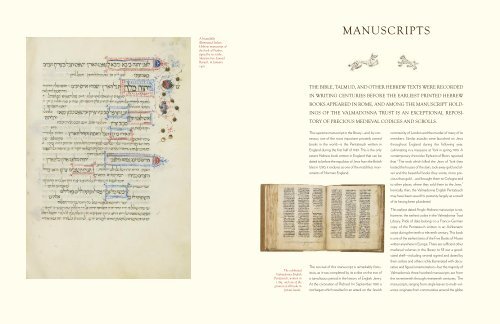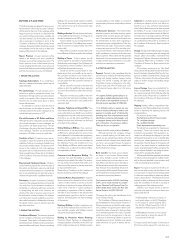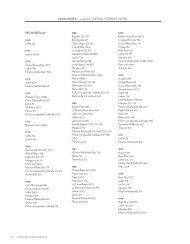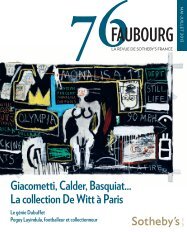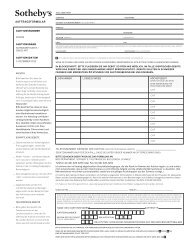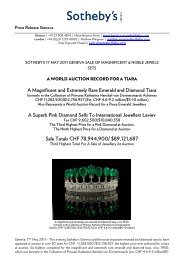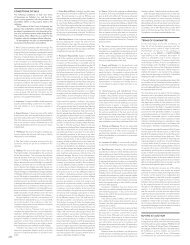Valmadonna Trust Library Brochure - Sotheby's
Valmadonna Trust Library Brochure - Sotheby's
Valmadonna Trust Library Brochure - Sotheby's
Create successful ePaper yourself
Turn your PDF publications into a flip-book with our unique Google optimized e-Paper software.
The<br />
EARLIEST<br />
HEBREW PRINTING<br />
UNDOUBTEDLY THE MOST MOMENTOUS TRANSFORMATION THAT<br />
JACK LUNZER EFFECTED IN THE PLAN OF THE LIBRARY WAS THE<br />
EXTENSION OF ITS PERIOD OF INTEREST BOTH FORWARD, TO THE<br />
DAWN OF THE TWENTIETH CENTURY, AND—MORE SIGNIFICANTLY—<br />
REARWARD, TO THE BIRTH OF HEBREW PRINTING AND EARLIER.<br />
Books printed during the fifteenth century have<br />
always been the pride of any great library. And even<br />
though copies of nearly 29,000 incunable editions<br />
survive, fewer than 140 of these are printed in<br />
Hebrew. (The term “incunable” comes from the Latin<br />
for swaddling clothes or cradle and is applied to<br />
books produced during the “infancy” of Western<br />
typographic printing.) Remarkably the <strong>Valmadonna</strong><br />
<strong>Trust</strong> holds copies of nearly half of all Hebrew editions<br />
printed during the incunable period. No other<br />
private library comes close to this level of<br />
comprehensiveness, and only a handful of national<br />
and academic libraries are comparable to it.<br />
Printing was founded in Germany, at the Mainz shop<br />
of Johann Gutenberg in the early 1450s. But because<br />
the German guilds would not admit Jewish apprentices,<br />
Hebrew printing did not begin until the new<br />
technology had spread to Italy. About 1470, shortly<br />
after the Germans Sweynheym and Pannartz established<br />
their press at Rome, Jews were permitted to<br />
work in Italian printing shops and books for the “People<br />
of the Book” were being set in newly cast Hebrew<br />
type. These first Hebrew books share many similarities<br />
with Latin editions printed in Rome at the same<br />
period, and it is likely, as Brad Sabin Hill has<br />
remarked, “that Jews and Christians collaborated in<br />
these early typographic efforts, perhaps even working<br />
in the same shop.” By the year 1500, at least thirty<br />
Hebrew presses had been opened, primarily in Italy<br />
and the Iberian Peninsula.<br />
Although he had acquired a few titles earlier, Jack<br />
Lunzer began the purposeful acquisition of Hebrew<br />
incunables in the 1970s, probably the latest date at<br />
which a significant collection could still be assembled.<br />
The most frequently printed Hebrew incunable texts<br />
were scriptural and legal works, mirroring the predominating<br />
trend among non-Jewish printers of the<br />
period. Secular titles were also published,<br />
including grammars, as well as philosophical, literary,<br />
and medical treatises. The <strong>Valmadonna</strong> <strong>Trust</strong> is rich<br />
in all these categories.<br />
The library contains numerous editions of the<br />
Hebrew Bible or divisions thereof, including the<br />
David Solomon Sassoon copy of the 1490 Híjar<br />
Pentateuch in Hebrew and Aramaic, printed on<br />
vellum, the last dated Hebrew book printed in Spain<br />
before the expulsion of the Jews in 1492. The first<br />
printed editions of Hebrew scripture were actually<br />
preceded off the press by works of Biblical exegesis,<br />
and among its many treasures of early printing, the<br />
<strong>Valmadonna</strong> <strong>Trust</strong> possesses a complete copy of the<br />
only signed imprint from the very first Hebrew printing<br />
shop. This editio princeps of Nahmanides’ commentary<br />
on the Pentateuch, Perush ha-Torah,<br />
contains a proto-colophon announcing that the book<br />
was printed “by the hands of Obadiah and Manasseh<br />
Top: The Pentateuch,<br />
in Hebrew and<br />
Aramaic. Híjar, 1490.<br />
The third Spanish<br />
edition of the<br />
Pentateuch.<br />
Printed on vellum.<br />
Bottom: Mishnah,<br />
with commentary by<br />
Maimonides. Naples,<br />
1492. One of the<br />
first illustrated<br />
Hebrew books.


